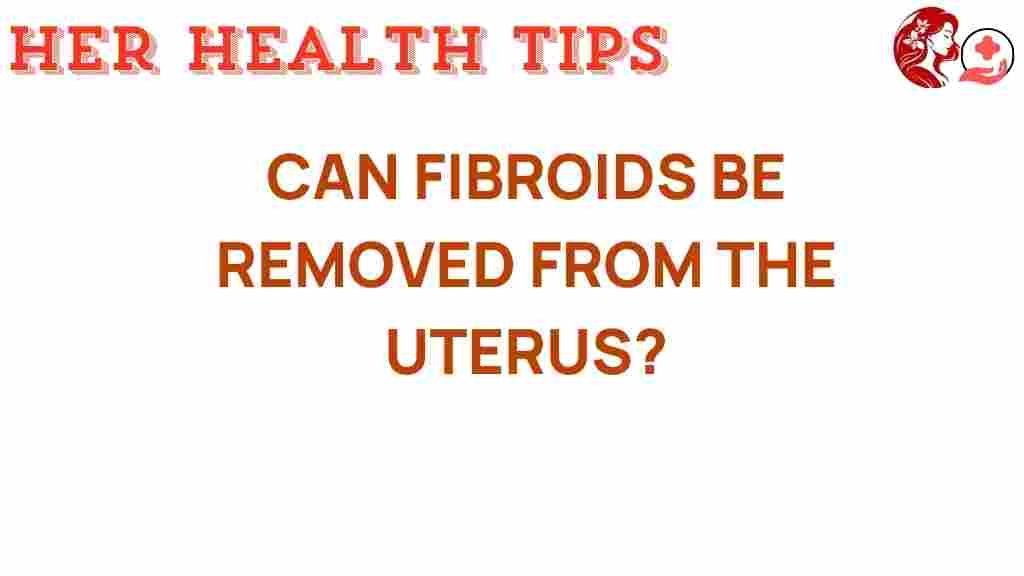Unveiling the Truth: Can Fibroids Truly Be Removed from the Uterus?
Fibroids are non-cancerous growths that can develop in the uterus, often affecting women’s health significantly. The presence of fibroids can lead to a range of symptoms, including heavy menstrual bleeding, pelvic pain, and complications during pregnancy. As women seek effective treatment options, the question arises: Can fibroids truly be removed from the uterus? This article aims to explore the various removal methods, debunk common myths, and provide insights into the diagnosis and treatment of uterine fibroids.
Understanding Fibroids: What Are They?
Fibroids, also known as uterine leiomyomas, are benign tumors that originate from the smooth muscle of the uterus. They can vary in size, number, and location within the uterus, and their growth is influenced by hormonal factors, particularly estrogen. While many women with fibroids may experience no symptoms, others may face significant health issues.
Symptoms of Fibroids
Recognizing the symptoms of fibroids is crucial for timely diagnosis and treatment. Common symptoms include:
- Heavy menstrual bleeding or prolonged periods
- Pelvic pain or pressure
- Frequent urination
- Constipation
- Back pain
- Infertility or complications during pregnancy
If you experience any of these symptoms, it is essential to consult a healthcare professional for proper evaluation and diagnosis.
The Diagnosis of Fibroids
Diagnosing fibroids typically involves several steps:
- Medical History: Your doctor will take a detailed medical history, discussing symptoms and any family history of fibroids.
- Physical Examination: A pelvic examination may reveal the presence of fibroids through abdominal or vaginal palpation.
- Imaging Tests: Ultrasound, MRI, or CT scans are often used to confirm the presence of fibroids and determine their size and location.
Accurate diagnosis is key to determining the best treatment options available for fibroid removal.
Exploring Treatment Options for Fibroids
When it comes to managing fibroids, several treatment options exist, ranging from non-invasive methods to surgical interventions. The choice of treatment depends on factors such as the severity of symptoms, the size and location of the fibroids, and the woman’s reproductive plans.
Non-Surgical Treatment Options
For women who experience mild symptoms or wish to avoid surgery, non-surgical treatment options include:
- Medications: Hormonal therapies, such as birth control pills or GnRH agonists, can help manage symptoms by regulating hormone levels.
- Uterine Artery Embolization (UAE): This minimally invasive procedure cuts off blood flow to the fibroids, causing them to shrink.
- Myomectomy: A surgical procedure that removes fibroids while preserving the uterus, allowing for future pregnancies.
Surgical Options for Fibroid Removal
If non-surgical treatments are ineffective or if fibroids cause severe symptoms, surgical options may be necessary. These include:
- Hysterectomy: The complete removal of the uterus, which is a permanent solution. This option is typically considered for women who no longer wish to conceive.
- Myomectomy: As mentioned earlier, this surgery removes fibroids while preserving the uterus. It can be performed through various methods, including laparoscopic, hysteroscopic, or abdominal approaches.
Both hysterectomy and myomectomy have their benefits and risks. It’s important to discuss these options thoroughly with your healthcare provider.
Debunking Myths About Fibroids and Their Removal
Many myths surround fibroids and their treatment. Here are some common misconceptions:
- Myth 1: All fibroids need to be removed.
Fact: Not all fibroids require removal, especially if they are asymptomatic. - Myth 2: Fibroid removal always leads to infertility.
Fact: Myomectomy can preserve fertility, and many women go on to have successful pregnancies post-surgery. - Myth 3: Hysterectomy is the only solution for fibroids.
Fact: Many effective non-surgical and surgical options exist.
Understanding the facts about fibroids is essential for making informed decisions about treatment options.
Step-by-Step Process of Fibroid Removal
Here’s a step-by-step process for fibroid removal, whether through surgery or other methods:
1. Consultation and Diagnosis
Begin with a consultation with a gynecologist. They will conduct a thorough examination and diagnostic tests to determine the presence and extent of fibroids.
2. Discuss Treatment Options
Once diagnosed, discuss the available treatment options with your healthcare provider. Consider your symptoms, reproductive plans, and the pros and cons of each method.
3. Prepare for Treatment
Depending on the chosen treatment, you may need to prepare physically and mentally. This could involve dietary adjustments, medication, or planning for recovery time.
4. Undergoing Treatment
Follow the agreed-upon plan for treatment. If surgery is involved, ensure you understand the procedure and anesthesia process.
5. Recovery and Follow-Up
Post-treatment, recovery times vary based on the method used. Attend follow-up appointments to monitor healing and address any concerns.
Troubleshooting and Aftercare
After fibroid removal, it’s important to follow specific aftercare recommendations to ensure a smooth recovery:
- Monitor Symptoms: Keep track of any symptoms like heavy bleeding or severe pain and report them to your doctor.
- Follow Dietary Recommendations: A balanced diet can promote healing. Consider foods rich in iron and vitamins.
- Rest and Limited Activity: Allow your body to recover. Follow your doctor’s advice regarding physical activities.
Additionally, if you face any challenges post-treatment, don’t hesitate to reach out to your healthcare provider for support and guidance.
Conclusion
Fibroids can indeed be removed from the uterus, and various treatment options are available. Whether through non-surgical methods or surgical intervention, women have the opportunity to manage their symptoms and improve their overall health. It’s crucial to dispel myths surrounding fibroids and understand the facts, enabling women to make informed choices regarding their reproductive health.
If you’re experiencing symptoms related to fibroids, consult a healthcare professional to discuss your options. Remember, knowledge is power when it comes to your health!
For more information on women’s health and fibroid treatment, visit Women’s Health Organization.
And for detailed surgical options, check out Healthline’s fibroid removal guide.
This article is in the category Reproductive and created by HerHealthTips Team
